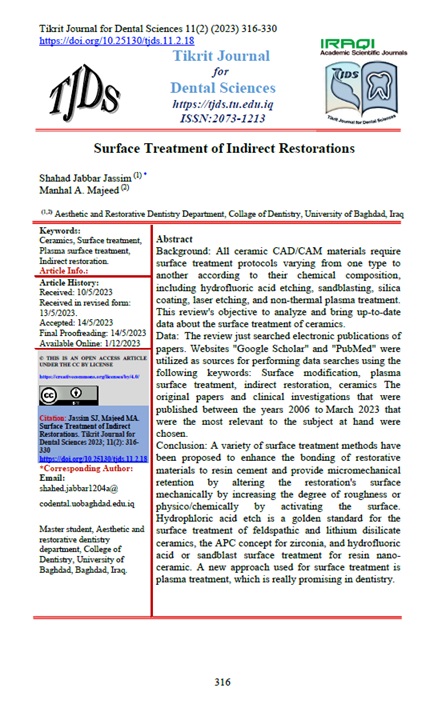Surface Treatment of Indirect Restorations
Shahad Jabbar Jassim
Aesthetic and Restorative Dentistry Department, Collage of Dentistry, University of Baghdad, Iraq
Manhal A. Majeed
Aesthetic and Restorative Dentistry Department, Collage of Dentistry, University of Baghdad, Iraq
DOI: https://doi.org/10.25130/tjds.11.2.18
Keywords: Ceramics, Surface treatment, Plasma surface treatment, Indirect restoration
Abstract
Background: All ceramic CAD/CAM materials require surface treatment protocols varying from one type to another according to their chemical composition, including hydrofluoric acid etching, sandblasting, silica coating, laser etching, and non-thermal plasma treatment. This review's objective to analyze and bring up-to-date data about the surface treatment of ceramics.
Data: The review just searched electronic publications of papers. Websites "Google Scholar" and "PubMed" were utilized as sources for performing data searches using the following keywords: Surface modification, plasma surface treatment, indirect restoration, ceramics The original papers and clinical investigations that were published between the years 2006 to March 2023 that were the most relevant to the subject at hand were chosen.
Conclusion: A variety of surface treatment methods have been proposed to enhance the bonding of restorative materials to resin cement and provide micromechanical retention by altering the restoration's surface mechanically by increasing the degree of roughness or physico/chemically by activating the surface. Hydrophloric acid etch is a golden standard for the surface treatment of feldspathic and lithium disilicate ceramics, the APC concept for zirconia, and hydrofluoric acid or sandblast surface treatment for resin nano-ceramic. A new approach used for surface treatment is plasma treatment, which is really promising in dentistry.




